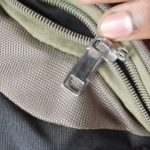
Currently, there are three main types of zippers available on the market. Let’s dive into the details of these zipper types to understand them better. Knowing the type of zipper will help you determine the most effective way to fix a broken zipper.
-
Plastic Zippers
These zippers are made of plastic and are also known as nylon zippers, coil zippers, or polyester zippers. Their teeth are made from synthetic fibers. They come in various sizes, making them suitable for different backpack models and sizes.
-
Vislon Zippers
Vislon zippers, also known as Delrin or resin zippers, are made from POM (polyacetal) plastic. They are widely used not only in backpacks but also in other items like jackets, handbags, and pants due to their durability and versatility.

How to Fix a Broken Zipper
-
Metal Zippers
Metal zippers are typically made from brass, nickel, or aluminum and are commonly used in backpacks. Their robust construction makes them a popular choice for heavy-duty applications.
Common Zipper Issues
- The zipper is stuck and won’t move up or down.
- The zipper moves but the teeth don’t align properly.
- The zipper closes but doesn’t lock securely.
How Zippers Work
Understanding how zippers work is key to fixing a broken zipper. Each zipper consists of two rows of teeth with interlocking hooks and grooves. When the slider is pulled, these teeth mesh together, creating a secure closure. The slider’s angle and alignment are crucial for smooth operation.

For a zipper to function properly, the hooks and grooves must be uniform in size and shape, and precisely aligned. When closed, the zipper forms a secure connection that’s difficult to separate unless the slider is moved in the opposite direction.
8 Simple Ways to Fix Zipper Issues
1. Use a Pencil to Lubricate the Zipper

First, check if any threads or fabric are caught in the zipper. Rub the pencil tip along the zipper teeth. The graphite acts as a lubricant, making the zipper glide smoothly. Rub it back and forth until the zipper moves freely. Test the zipper by pulling it up and down a few times.
2. Use a Candle

A traditional remedy for stuck zippers is using candle wax. Simply rub the end of a candle along the zipper teeth, and it should move smoothly again.
3. Use Soap

Mix a bit of soap or detergent with water, dip a damp cloth into the solution, and rub it along the zipper while moving it up and down.
4. Use Lip Balm

Lip balm, a staple in many beauty kits, can also be used to lubricate zippers. Apply a small amount of lip balm along the zipper teeth, then move the zipper up and down several times to distribute it evenly.
5. Fix Misaligned Zipper Teeth

If the zipper teeth are misaligned, use pliers to gently adjust any crooked teeth back into place. Ensure all teeth are straight for smooth operation.
6. Replace a Broken Slider

If the slider is broken, use a paperclip or similar item as a temporary replacement. Simply thread it through the zipper teeth to create a functional slider.
7. Fix a Zipper Stuck in Fabric

If the zipper is stuck in fabric or threads, gently move the slider back to its original position and remove any trapped material. Be cautious when sewing zippers to avoid such issues.
8. Fix a Separated Zipper
A separated zipper can result from various causes, such as poor quality, wear and tear, or debris. Here’s how to fix it:

- Step 1: Move the slider to the bottom stop.
- Step 2: Remove the bottom stop using pliers.
- Step 3: Reinsert the zipper tape into the slider and test the zipper. If it works, reattach the stop.
Conclusion
This guide provides simple and effective tips for fixing zipper issues on backpacks, jackets, and other items. With these methods, you can quickly resolve common zipper problems and extend the life of your belongings.
Good luck!
With over 15 years of experience in web design and development, I’ve helped hundreds of businesses create comprehensive website strategies for sustainable growth and profitability.
8 Quick Fixes for a Broken Zipper: Easy Solutions to Try
Zippers have become incredibly integral to our daily lives, a humble invention that has revolutionized the way we secure and access our belongings. From fashion to function, the zipper has left an indelible mark on modern society, offering convenience, security, and style in equal measure. Its ubiquitous presence in our garments, accessories, and even home décor underscores its versatility and enduring appeal. This unassuming fastener has undoubtedly earned its place as one of the most important inventions of our time, shaping industries and influencing cultural trends along the way.
8 Simple Ways to Fix a Broken Zipper When Faced with a Problem
Zippers have become extremely useful in our daily lives, with wide-ranging applications from shoes to clothing, tents, sleeping bags, backpacks, wallets, and even suitcases that require zippers. For those who use products with zippers, it is certain that they will encounter issues with stuck or damaged zippers. So, how can these problems be fixed? In this article, meohay.vn will share some quick ways to repair broken zippers. Feel free to reference our suggestions.

































